If you’re wondering how to transition to a vegan diet, it can be difficult knowing where to start. There’s more to adapting a vegan lifestyle than simply giving up meat and dairy, and all the information out there can feel like a minefield. If this sounds like you – you’ve come to the right place!
I’ve put together this ultimate guide on how to go vegan for beginners. You’ll find 10 steps to help with the transition, from small tweaks you can start to make today, to habit changes, shopping hacks and key questions to consider. Hopefully there’s something for everyone!
Step 1: Identify and focus on your ‘why’
There are many reasons why someone might decide to become vegan, vegetarian or flexitarian. Whether it’s for environmental, ethical or health reasons, identifying your ‘why’ can keep you motivated and focused.
Some people find it helpful to frequently remind themselves why they’ve made this choice. At the start, I kept myself motivated by watching (and re-watching) any eye-opening documentaries such as Cowspiracy, What the Health and the Game Changers. I also like to follow social media accounts for food inspiration.
But do whatever keeps you motivated! This can be reading books, listening to podcasts, following blogs or posting a simple reminder on your fridge.
Step 2: Realise it’s not a race
When it comes to it, everyone’s journey will be different.
Take as much time as you need, because going slowly can help with the transition.
You could start by cutting out the animal products you’re least keen on (for me it was milk and cheese), and then gradually eliminating animal products you find harder to give up (for me it was milk chocolate, for Oli it was mozzarella on pizza and tuna).
Perhaps during your transition you’ll decide that being flexitarian (where you only occasionally eat animal products) is the right choice for you. Maybe it will take you a little longer than expected to become fully vegan, or maybe you find the transition happens quickly!
Whatever the journey, remember to be kind to yourself, and know that any small changes you make add up to big differences.
Step 3: Meal plan and prep like a pro
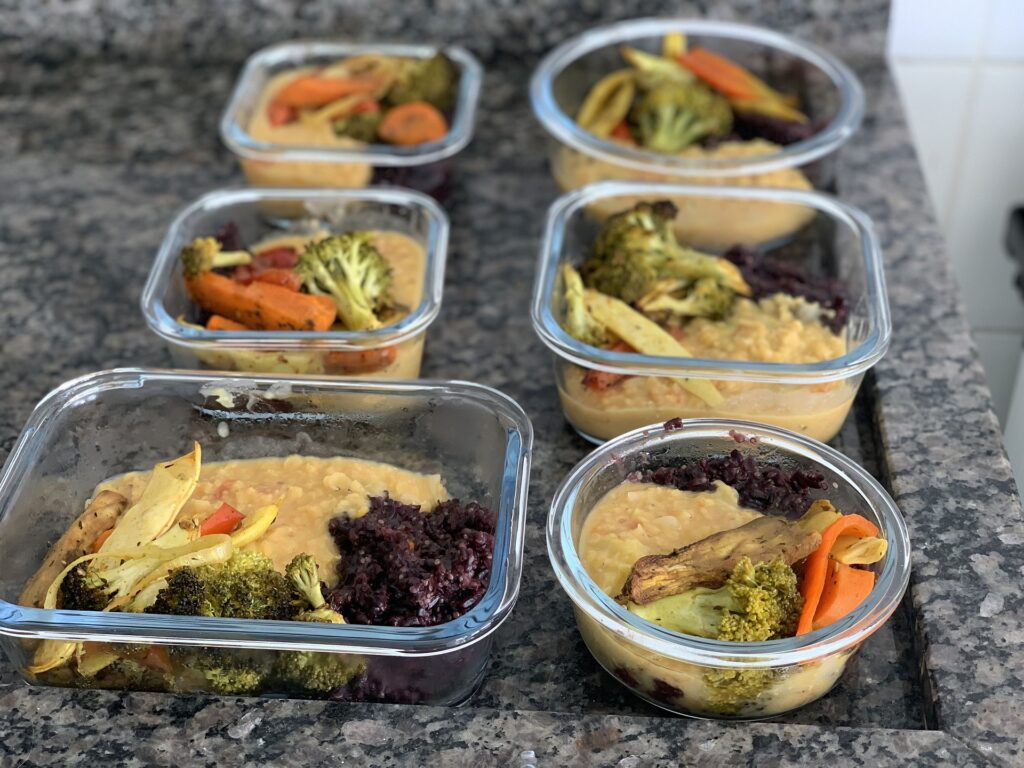
Meal prepping and planning can be really useful, especially on those days where you don’t know what to cook or you need something quickly. Admittedly, this can be a time-consuming commitment. But dedicating a few hours to the preparation of interesting and balanced meals not only saves you time in the long-run, but also keeps you on track and motivated.
After all, there’s nothing worse than coming home after a long day’s work and finding nothing in the fridge for dinner.
Plan out balanced meals
When it comes to planning your meals, try sticking to old favourites, especially at first (see our guide for some easy vegan swaps). In general, aim for half your plate to be veggies, a quarter protein and the last quarter carbohydrates, plus 5+ different fruits and veggies a day.
It’s important that meals are balanced to make sure you’re getting a range of nutrients. Even though rice is vegan, a plate of just boiled rice isn’t a balanced meal, nor is it sustainable for long-term health (the same goes for if you just ate lettuce or tofu).
Stock your cupboard with essentials
Having a cupboard stocked with basic essentials can be a game-changer. You’ll thank me when you think you have nothing to cook or it’s a Tuesday night and you can’t quite justify ordering a takeaway so early in the week.
Go the extra mile
You certainly don’t have to become a gourmet chef overnight! As your taste buds change, you may find yourself experimenting more in the kitchen. We’ve found real joy by adding little extra touches that elevate meals.
Think topping a curry with fresh coriander, a stir fry with toasted sesame seeds or fruit salads with a squeeze of lime – not only will this boost the nutrition of the dish, it will also add a welcome kick of flavour!
Step 4: Veganise your favourite dishes
There are so many plant-based substitutes on the market now, with more coming out all the time. It’s easier than ever to make like-for-like swaps – so you can veganise your favourite dishes. You can have a diet that on face-value, looks pretty similar to your old one!
Step 5: Get your creative juices flowing
Moving towards a more plant-based diet can be a fantastic opportunity to try foods you’ve never had before and get your creative juices flowing in the kitchen! After all, variety is the spice of life. Have you had jackfruit ‘pulled pork’ before? Or oyster mushroom ‘chicken’? How about scrambled ‘egg’ tofu? You might not like every new thing you try, but that’s all part and parcel of the process.
If you’re anything like me, you’ll love discovering new restaurants. Trying out new plant-based restaurants is a great way to discover new dishes, support the community and (not to mention) have a night off from washing up! Recently we’ve started to enjoy recreating dishes we’ve had in restaurants at home. It’s a nice challenge and means we get to enjoy the dish again and again!
Top tip: Download the Happycow app to find vegan and vegetarian options in your area. It’s especially useful if you’re abroad and don’t know an area that well.
Step 6: Nerd out on nutrition and supplements you may need
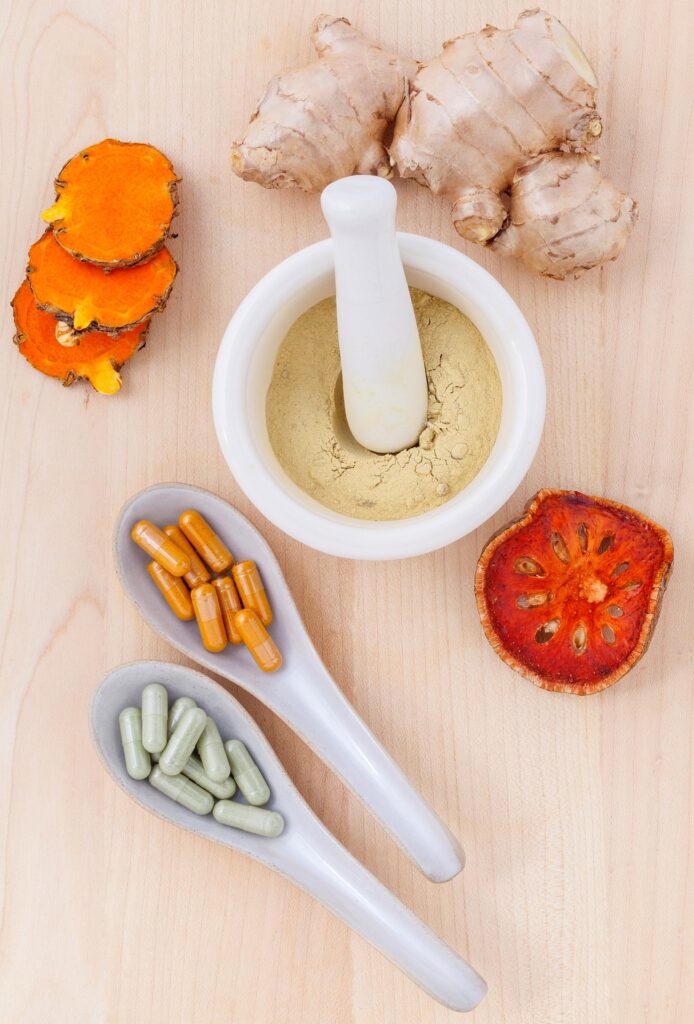
You don’t need a nutrition degree to thrive on a vegan diet, even if it can feel that way at times. It’s always sensible to read up on the subject when making any change to your diet. If the plethora of nutrition-related information seems overwhelming, or if you’re worried about it, speak to a nutritionist, dietician or doctor. Further to this, you can even get blood tests to check for any potential deficiencies.
In terms of supplements, everyone will have different needs. However, if you’re maintaining a vegan diet, the general consensus is that you should take a B12 supplement. Our bodies need B12, and sufficient intake is typically only achieved by eating animal products. B12 is added to some foods, but in all likelihood, eating fortified foods won’t be enough for what you need. Always do your own research before taking any supplement, and again, if you’re worried, speak to a health professional.
Step 7: Learn to read labels like a ninja
Remembering to check labels and recognising what to look out for will quickly become second nature.
So many products look vegan, and then you turn to the ingredients list to see that it’s not! And it doesn’t help that there are so many different names for milk; casein and caseinate, curds, galactose, hydrolysates, lactalbumin, lactoglobulin, rennet and whey, to name just a few.
But that’s not all. There are items that you might be surprised aren’t vegan, because of unexpected ingredients or how it is manufactured. How could some sweets, soft drinks and alcohol not be vegan, I hear you cry? Check out my deep dive on the subject and you’ll find out why.
And then we have ‘May contain milk and eggs’ labels. These are legal disclaimers stating that the product has been made in a facility that handles animal products, and may have come into contact with them. It will be up to you to decide if you’re happy to consume the product.
The takeaway? Check your labels and set your own boundaries (more on that in Step 10).
Step 8: Embrace the Zen Vegan way
There is no such thing as a perfect vegan.
This can be difficult to remember, especially with social media portraying what seem like picture-perfect influencers living perfect vegan lives. But you will make mistakes, like everyone else does. We still have slip-ups even after being vegan for years!
Making a mistake doesn’t make you a bad person or a failure; it makes you human.
When you make a mistake, try not to chastise yourself. Instead, learn from it. Recognise how it happened, and how you can avoid it in future. If you can, try not to let it discourage you from reaching your goals.
Step 9: Focus on what you can eat
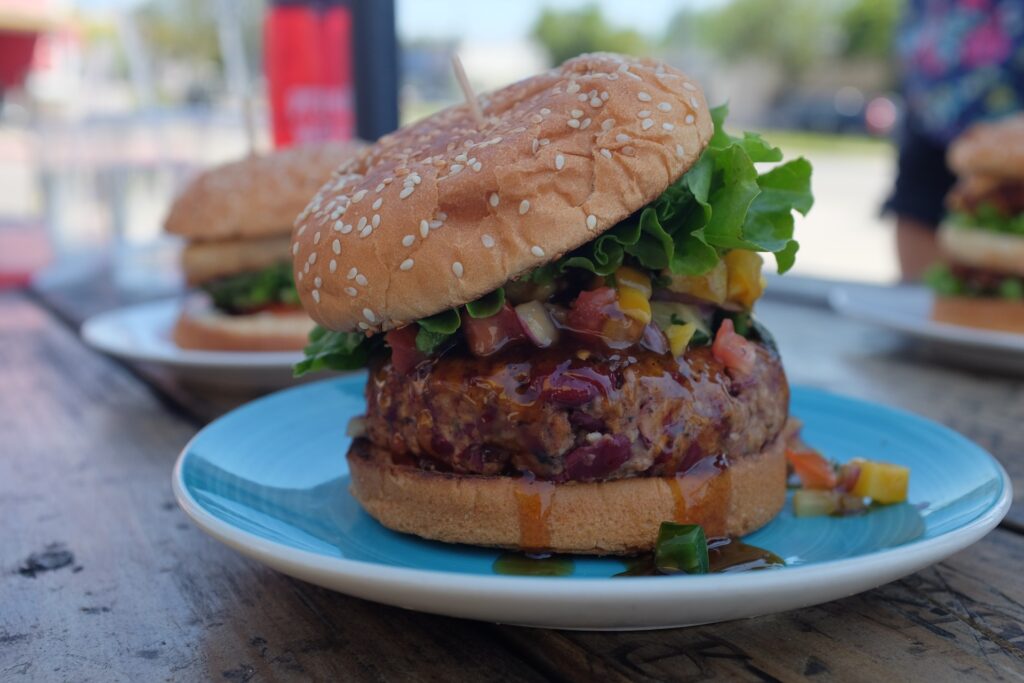
Moving towards a vegan lifestyle can feel daunting, especially if you focus on the word can’t – what you can’t eat, what you can’t wear, what you can’t do… Instead, try focusing on everything you can do. If you write down every fruit, vegetable, pulse, bean and nut, the list is going to be pretty long, right? This simple mindshift can make a world of difference in keeping you motivated.
I remember an auntie (after finding out I was vegan) coming up to me and exclaiming, “Eseelle! What do you eat?!” My cousin promptly started listing all the Arabic foods that I could eat. Based on the look on my Aunt’s face, she’d never thought twice about those items being vegan, which quickly put an end to my interrogation.
The moral of the story? There’s more you can eat than you (or others!) may realise, and veganism isn’t as restrictive as you might think.
Step 10: Set your own boundaries
It’s important to set your own boundaries when it comes to veganism – don’t worry about what everyone else is doing, because you have to do what’s right for you.
Everyone has their own moral compass, and the line isn’t always so clear. What to do with those suede shoes you haven’t had a chance to wear yet? Or your cosiest wool jumper you got for Christmas? What about your favourite biscuits that only your grandma makes you?
Let’s take a look at an example in more detail. Allow me to set the scene – you visit your mum who has baked you’re favourite cake for your birthday. You sit through the whole happy birthday song and candle blowing routine, knowing full well there is eggs and dairy in this cake. Then your mum offers you a slice. But you’re vegan now… what would you do?
When this happened to me, there were many scenarios that ran through my head: I could refuse the slice, at the risk of hurting my mum’s feelings. I could take a slice home and throw it away because it has egg in it, but this could be more wasteful and disrespectful to the chick’s potential life? I could give it away to someone who does eat eggs and dairy, but would that be encouraging others to eat animal products? I know I feel guilty that mum made the cake for me, and I don’t want to lie to her when she asks me how it was. I could just eat a slice this once – after all, it is my birthday.
What I’m trying to highlight, is that sometimes difficult scenarios will pop up, and the solution isn’t always a flat out ‘no’. Ultimately, I decided to have some cake. I knew it would go to waste if I didn’t have some, and I was still transitioning into being vegan. I used it as an opportunity to explain to my mum that I was changing my diet, so we wouldn’t have this situation again in the future (this was very optimistic on my part – but that’s another story!).
You might also decide that your veganism goes beyond food (this is the difference between being a dietary vegan and ethical vegan). You might decide that you don’t want to use any products that are of animal origin, such as leather or suede, or use anything that have been tested on animals, like some cleaning and beauty products.
What you’ll have to decide is what to do with the existing goods you have, you might want to throw them all away and get new vegan-friendly items. You might decide that throwing them away for life in landfill doesn’t sit right with you. Oli and I decided that for us, it felt wasteful to throw everything away. So we used up the products we had, then once they were finished or broken, we only bought new vegan-friendly alternatives.
Ultimately, I (or anyone else) cannot answer these questions for you. You can only do what’s right for yourself, but I hope some of my examples have helped you realise that the lines aren’t always clear cut and if you do come across difficult circumstances, you won’t have been the first or the last!
Final Comments
As you have seen, there are a lot of things to consider when transitioning to a vegan diet. We’ve covered a lot, from how to tackle the supermarket to boundary setting.
Remember, be kind to yourself and take the journey at your own pace. It may not always be easy, and you will likely make mistakes, but remind yourself that every little bit you do counts towards making this world a better place.
We hope you’ve found this guide to going vegan helpful but if you have any concerns, questions or would just like to chat – please reach out to us, we’d love to hear from you!

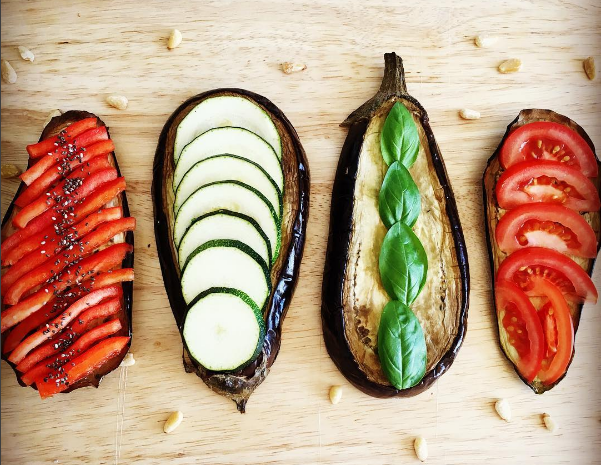

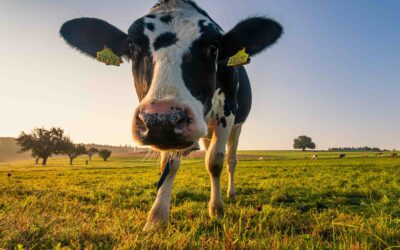

0 Comments